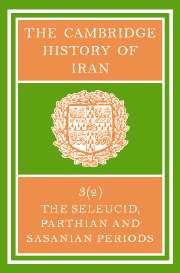Book contents
- Frontmatter
- PART 5 INSTITUTIONS
- PART 6 RELIGIOUS HISTORY
- PART 7 ART HISTORY
- PART 8 LANGUAGES AND LITERATURE
- 31 PARTHIAN WRITINGS AND LITERATURE
- 32(a) ZOROASTRIAN PAHLAVĪ WRITINGS
- (b) THE MANICHAEAN MIDDLE PERSIAN WRITINGS
- (c) MIDDLE PERSIAN INSCRIPTIONS
- 33 SOGDIAN LANGUAGE AND LITERATURE
- 34 KHOTANESE SAKA LITERATURE
- 35 KHWARAZMIAN LANGUAGE AND LITERATURE
- 36 BACTRIAN LITERATURE
- PART 9 BIBLIOGRAPHY
- Bibliography
- Index
- Index of Greek words
- References
33 - SOGDIAN LANGUAGE AND LITERATURE
from PART 8 - LANGUAGES AND LITERATURE
Published online by Cambridge University Press: 28 March 2008
- Frontmatter
- PART 5 INSTITUTIONS
- PART 6 RELIGIOUS HISTORY
- PART 7 ART HISTORY
- PART 8 LANGUAGES AND LITERATURE
- 31 PARTHIAN WRITINGS AND LITERATURE
- 32(a) ZOROASTRIAN PAHLAVĪ WRITINGS
- (b) THE MANICHAEAN MIDDLE PERSIAN WRITINGS
- (c) MIDDLE PERSIAN INSCRIPTIONS
- 33 SOGDIAN LANGUAGE AND LITERATURE
- 34 KHOTANESE SAKA LITERATURE
- 35 KHWARAZMIAN LANGUAGE AND LITERATURE
- 36 BACTRIAN LITERATURE
- PART 9 BIBLIOGRAPHY
- Bibliography
- Index
- Index of Greek words
- References
Summary
INTRODUCTION
The oldest known references to the region of Sogdiana occur in the Old Persian inscriptions and in the (Younger) Avesta. In the former, Sogdiana (suguda) is mentioned as a satrapy of the Achaemenian empire, listed between Bactria and Khwarazmia or between Bactria and Gandhāra. In a building inscription at Susa, lapis lazuli (kāsaka haya kapautaka “blue ‘kāsaka'”) and carnelian (sinkabruš) are said to have been brought from Sogdiana for the construction of the palace. In the Avesta the Sogdian area is referred to as suxδa- in a list of lands, between Margu/Marv and Khwarazm (xwāirizm); as suδδa- the area is said to be the second best, after airyanm waējō “the Aryan ‘range'” and before Margu/Marv, of the territories created by Ahura Mazdā and to have been visited by the Ahrimanic plague known as skaiti-, a term which seems to mean rather “thorn, weed” than “locust” as the Pahlavi translation (kullag “locust”) has it. Although these data provide only rough geographical delimitations, they establish Sogdiana as the areas around the cities of Bukhārā and Samarkand including part of the Farghāna valley.
As subjects of the Achaemenid rulers, the Sogdians (Σογδιανοι or Σογδοι) became known to the Greek world; a Sogdian contingent under the command of Azanes, son of Artaios, formed part of the Persian army which attacked and invaded Greece under Xerxes in 480 b.c. A century and a half later, resistance to Alexander the Great became apparent, in 329–8 b.c, in an unsuccessful offensive mounted by the Sogdians under the leadership of Spitamenes against the Macedonian garrison in the city of Maracanda/Samarkand.
- Type
- Chapter
- Information
- The Cambridge History of IranSeleucid Parthian, pp. 1216 - 1229Publisher: Cambridge University PressPrint publication year: 1983
References
- 1
- Cited by



